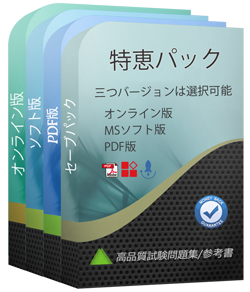無料デモをごダウンロードいただけます
様々な復習資料が市場に出ていることから、多くの候補者は、どの資料が適切かを知りません。この状況を考慮に入れて、私たちはIBM 000-833の無料ダウンロードデモを候補者に提供します。弊社のウェブサイトにアクセスしてObject Oriented Analysis and Design-Part1(Analysis)デモをダウンロードするだけで、000-833試験復習問題を購入するかどうかを判断するのに役立ちます。多数の新旧の顧客の訪問が当社の能力を証明しています。私たちの000-833試験の学習教材は、私たちの市場におけるファーストクラスのものであり、あなたにとっても良い選択だと確信しています。
Tech4Examはどんな学習資料を提供していますか?
現代技術は人々の生活と働きの仕方を革新します(000-833試験学習資料)。 広く普及しているオンラインシステムとプラットフォームは最近の現象となり、IT業界は最も見通しがある業界(000-833試験認定)となっています。 企業や機関では、候補者に優れた教育の背景が必要であるという事実にもかかわらず、プロフェッショナル認定のようなその他の要件があります。それを考慮すると、適切なIBM Object Oriented Analysis and Design-Part1(Analysis)試験認定は候補者が高給と昇進を得られるのを助けます。
000-833試験認定を取られるメリット
ほとんどの企業では従業員が専門試験の認定資格を取得する必要があるため、000-833試験の認定資格がどれほど重要であるかわかります。テストに合格すれば、昇進のチャンスとより高い給料を得ることができます。あなたのプロフェッショナルな能力が権威によって認められると、それはあなたが急速に発展している情報技術に優れていることを意味し、上司や大学から注目を受けます。より明るい未来とより良い生活のために私たちの信頼性の高い000-833最新試験問題集を選択しましょう。
000-833試験学習資料を開発する専業チーム
私たちは000-833試験認定分野でよく知られる会社として、プロのチームにObject Oriented Analysis and Design-Part1(Analysis)試験復習問題の研究と開発に専念する多くの専門家があります。したがって、我々のIBM certifications II試験学習資料が000-833試験の一流復習資料であることを保証することができます。私たちは、IBM certifications II 000-833試験サンプル問題の研究に約10年間集中して、候補者が000-833試験に合格するという目標を決して変更しません。私たちの000-833試験学習資料の質は、IBM専門家の努力によって保証されています。それで、あなたは弊社を信じて、我々のObject Oriented Analysis and Design-Part1(Analysis)最新テスト問題集を選んでいます。
Object Oriented Analysis and Design-Part1(Analysis)試験学習資料での高い復習効率
ほとんどの候補者にとって、特にオフィスワーカー、000-833試験の準備は、多くの時間とエネルギーを必要とする難しい作業です。だから、適切な000-833試験資料を選択することは、000-833試験にうまく合格するのに重要です。高い正確率がある000-833有効学習資料によって、候補者はObject Oriented Analysis and Design-Part1(Analysis)試験のキーポイントを捉え、試験の内容を熟知します。あなたは約2日の時間をかけて我々の000-833試験学習資料を練習し、000-833試験に簡単でパスします。
IBM Object Oriented Analysis and Design-Part1(Analysis) 認定 000-833 試験問題:
1. Which statement is true about grouping elements into a package?
A) Packages should not contain other packages.
B) Packages should contain a small number of elements to avoid confusion.
C) Packages should only be used on large projects requiring a large number of elements.
D) Elements in a package should share a logical, common grouping.
2. What are three architectural mechanism categories? (Choose three.)
A) implementation mechanisms
B) analysis mechanisms
C) design mechanisms
D) requirement mechanisms
3. During Architectural Analysis, a Software Architect wants to reduce the complexity of the system at work and improve its consistency. What should the Software Architect define to accomplish this?
A) coding rules
B) use-case realizations
C) analysis mechanisms
D) design mechanisms
4. Objects that are polymorphic _____.
A) may have the same operation names but the operations perform differently
B) must have the same attributes
C) can only be implemented through interfaces
D) share all the same operations, and the operations perform the same
5. Which two questions does the use of multiplicity on relationships allow you to answer?
(Choose
two.)
A) Is an object of a given type permitted to interact with objects of another type?
B) Is the relationship between objects permanent or temporary?
C) How many links can an object of one type maintain with objects of another type?
D) Is the relationship mandatory or optional?
質問と回答:
| 質問 # 1 正解: D | 質問 # 2 正解: A、B、C | 質問 # 3 正解: C | 質問 # 4 正解: A | 質問 # 5 正解: C、D |


 弊社は製品に自信を持っており、面倒な製品を提供していません。
弊社は製品に自信を持っており、面倒な製品を提供していません。


 竹内**
竹内**


